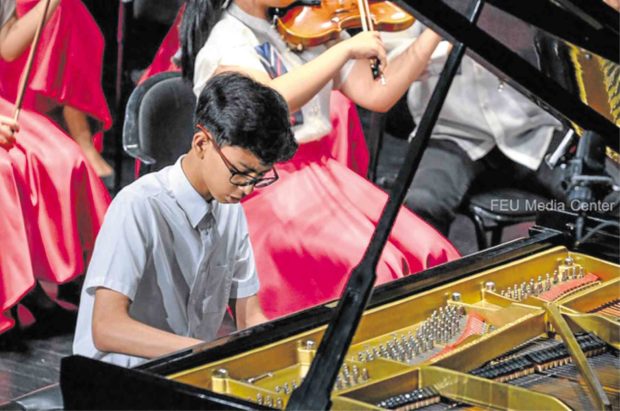
Young pianist Jeffrey Ching Jr. made an impressive Manila debut when he played Haydn’s piano concerto in D major with the Manila Symphony Junior Orchestra (MSJO) conducted by Jeffrey Solares in a recent concert at the Far Eastern University (FEU) Auditorium.
The concert, “In Pursuit of Excellence,” opened FEU’s 2019-2020 cultural season while marking the 70th anniversary of the FEU Auditorium, said Martin Lopez, executive director of the FEU Pressident’s Committee on Culture.
The auditorium was the popular concert venue in the 1950s that predated the Cultural Center of the Philippines, which was established in 1969. Designed by National Artist for Architecture Pablo Antonio, the FEU Auditorium is considered a modern Art Deco heritage structure that continues to be a premiere venue for the performing arts.
Martin said that the auditorium had housed before the Manila Symphony Orchestra (MSO), and the recent concert celebrates the strong ties between FEU and the MSO through its junior version, the MSJO, which made its debut performance along with the young Ching.
Vienna winner
MSJO won last year the first prize of the 12th Summa Cum Laude International Music Competition in Vienna, Austria. Its principal patron is Standard Insurance Inc.
Son of the prominent composer Jeffrey Ching and soprano Andion Fernandez, Ching Jr. is a piano scholar of the Julius-Stern-Institut, the preconservatoire level of the prestigious Universität der Künste, Berlin. He recently garnered the first prize of the Jugend Musiziert music competitions in Germany.
At the outset, MSJO set the mood for enraptured listening with its bouncy rendition of Mozart’s Divertimento in D Major. The piece was played by MSJO during the Vienna competition, noted Solares.
Solares’ annotations contributed to the audience’s intelligent appreciation of classical pieces. He also took time to introduce the instruments and what they contributed to the overall orchestral music.
The orchestra played with finesse, displaying its winning form, dishing out both Philippine as well as standard European pieces. Among them were Peña’s “Bahay Kubo,” scored in the tradition of Bachian “prelude and fugue”; the lilting scherzo of Dvorak, and the refreshing Bach Concerto for Two Violins (played absorbingly by Cedric Rafael Uson on violin 1 and Jiliana Regalario on violin 2).
On the piano, Ching Jr. sat coolly and breezed through Haydn’s concerto. A well-tempered singing touch and a finely crafted tonal balance between the hands was noted.
There were no choreographed movements as he sunk his nimble fingers on the keyboard. His brilliant tones were enough to convey an evolving sensitive artistry sans bodily movements.
He brought out the exuberance of the first movement that Haydn scored on a single theme. The cadenza, composed by his prolific father, Jeffrey Sr., showcased both thematic and rhythmic restatements scored to show intelligent musicality.
Toward the end the pianist stood up and struck the piano strings to give a glissando effect. This was the novel addition of an avant-garde technique known as “piano string.” It might seem anachronistic to the classical stylistic form of the piece, but in fact was not. It actually gave a contemporary flavor to the cadenza, indeed a novel, creative approach that did not at all alter its classical orientation as the strings rather than the keys were struck. Thus, Ching Sr. brought Haydn to the contemporary horizon.
The movement was starkly contrasted by the somber slow movement that once more demanded the pianist’s musicality, especially in the elaborate solo part.
The pianist again engaged the attention of the audience as he brilliantly essayed the playful final movement scored in rondo form. Thunderous applause punctuated by crisps shouts of bravi greeted him in the end. —CONTRIBUTED